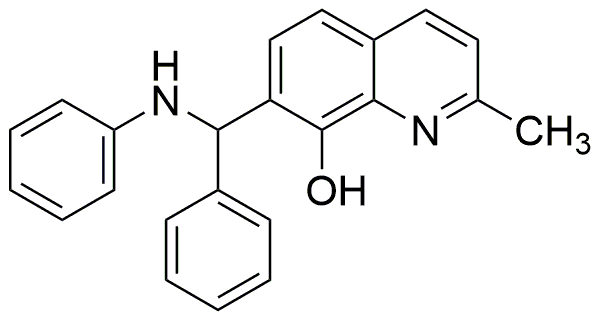NSC 66811 is widely utilized in research focused on:
- Anticancer Research: This compound has shown potential in targeting specific cancer cell lines, making it a valuable candidate for developing new cancer therapies.
- Pharmaceutical Development: Its unique structure allows for modifications that can enhance drug efficacy, particularly in creating novel treatments for various diseases.
- Biochemical Studies: Researchers use NSC 66811 to study enzyme interactions and metabolic pathways, providing insights into cellular processes and disease mechanisms.
- Material Science: The compound can be incorporated into polymers and coatings, improving their properties such as durability and resistance to environmental factors.
- Diagnostic Applications: Its properties may assist in the development of diagnostic tools, helping in the early detection of diseases through innovative biosensors.
Informations générales
Propriétés
Sécurité et réglementation
Applications
NSC 66811 is widely utilized in research focused on:
- Anticancer Research: This compound has shown potential in targeting specific cancer cell lines, making it a valuable candidate for developing new cancer therapies.
- Pharmaceutical Development: Its unique structure allows for modifications that can enhance drug efficacy, particularly in creating novel treatments for various diseases.
- Biochemical Studies: Researchers use NSC 66811 to study enzyme interactions and metabolic pathways, providing insights into cellular processes and disease mechanisms.
- Material Science: The compound can be incorporated into polymers and coatings, improving their properties such as durability and resistance to environmental factors.
- Diagnostic Applications: Its properties may assist in the development of diagnostic tools, helping in the early detection of diseases through innovative biosensors.
Documents
Fiches de données de sécurité (FDS)
La FDS fournit des informations de sécurité complètes sur la manipulation, le stockage et l’élimination du produit.
Spécifications du produit (PS)
Le PS fournit une description complète des propriétés du produit, notamment sa composition chimique, son état physique, sa pureté et les exigences de stockage. Il détaille également les plages de qualité acceptables et les applications prévues du produit.
Certificats d'analyse (COA)
Recherchez des certificats d'analyse (COA) en saisissant le numéro de lot du produit. Les numéros de lot et de lot se trouvent sur l'étiquette d'un produit, après les mots « Lot » ou « Lot de fabrication ».
Numéro de catalogue
Numéro de lot/série
Certificats d'origine (COO)
Ce certificat d'exploitation confirme le pays dans lequel le produit a été fabriqué, et détaille également les matériaux et composants utilisés et s'il est issu de sources naturelles, synthétiques ou autres sources spécifiques. Ce certificat peut être requis pour les douanes, le commerce et la conformité réglementaire.
Numéro de catalogue
Numéro de lot/série
Fiches de données de sécurité (FDS)
La FDS fournit des informations de sécurité complètes sur la manipulation, le stockage et l’élimination du produit.
DownloadSpécifications du produit (PS)
Le PS fournit une description complète des propriétés du produit, notamment sa composition chimique, son état physique, sa pureté et les exigences de stockage. Il détaille également les plages de qualité acceptables et les applications prévues du produit.
DownloadCertificats d'analyse (COA)
Recherchez des certificats d'analyse (COA) en saisissant le numéro de lot du produit. Les numéros de lot et de lot se trouvent sur l'étiquette d'un produit, après les mots « Lot » ou « Lot de fabrication ».
Numéro de catalogue
Numéro de lot/série
Certificats d'origine (COO)
Ce certificat d'exploitation confirme le pays dans lequel le produit a été fabriqué, et détaille également les matériaux et composants utilisés et s'il est issu de sources naturelles, synthétiques ou autres sources spécifiques. Ce certificat peut être requis pour les douanes, le commerce et la conformité réglementaire.


